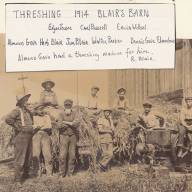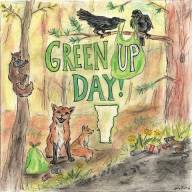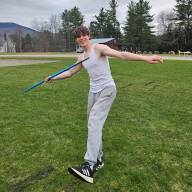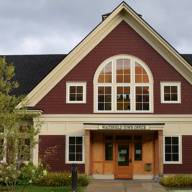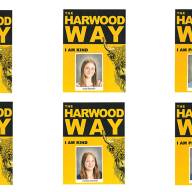“I've seen first-hand what a healing and therapeutic medium clay can be,” local potter Leigh Stockton said. “Mud on your hands centers and grounds. It helps to slow and focus the mind.”
Stockton teaches pottery at Blockhouse Studio – a community pottery studio founded by Warren resident Pamela Day in 2019. This past fall marked four years of running the space, which is as social as it is educational for well over 100 people.
A VOICE THROUGH CLAY
“I knew when I was opening the studio that I was sharing something I was passionate about. But I didn’t realize just how impactful it would be, and how therapeutic it would be for people,” Day said.
Blockhouse offers classes for kids and adults, as well as private lessons, 40 membership slots for those who want to work independently, and a variety of group workshops, which are taught by local and visiting potters – “people who have found a strong voice through clay,” Day said.
Last year, the studio hosted New York State-based Doug Peltzman, who gave technical demonstrations alongside reflections about his practice, and Ohio-based Stuart Gair, whose work deals with soda-firing – a process in which sodium oxide is vaporized in the kiln, leaving bright flashes of color on a vessel’s surface.
“I tell students all the time, to learn from as many people as possible,” Day said. “A student will have a breakthrough when something is explained or shown in a new way. We all have different bodies, and different ways of moving our hands.”
AN EXPERIMENT
Prior to opening Blockhouse, Day was making pottery at Mud Studio in Waterbury until she found it hard to travel there after having her second child. She then worked out of the space where Blockhouse is now hosted, when it functioned as a makeshift art studio run by Michael George – “a kind of experiment,” she said.
She saw the potential of the space, renting it out when it became available. With the help of her husband Andrew, who works as a carpenter, the two renovated it drastically – ripping up old carpet, replacing window sills, installing gutters, and building shelves, tables, and other fixtures.
Day started offering classes in late 2019, which was going well, until the pandemic hit. She adapted by renting pottery wheels out to people on a sliding scale, delivering them to peoples’ homes. People would then drop their unfired pieces off on a rack in front of the studio, and Day would fire them.
Day and Andrew also used that early period of intense social isolation to build out a store front, which now sells pottery made by instructors and members. “It felt like a gamble,” she said, to be creating a shop in the height of the pandemic, but years later, it brings in more revenue than she’d anticipated.
When lockdown restrictions were lifted, Day offered memberships in the form of independent studio time for those who had their classes canceled previously. That was a gamble too, she said, as most people didn’t have prior experience in making pottery, yet the studio wasn’t economically feasible without it.
LESSONS LEARNED
In late 2020, Day started offering classes again, and fast forward to today – the studio is going strong. Many teachers and members said it offers them an intensely positive social space – what Day called a “micro community.” Working with clay, too, has taught them a lot.
Member and Blockhouse shopkeeper Eric Potter said he enjoys how making pottery offers a contrast to his day job as a land use consultant. While that work deals with mostly hidden infrastructure – like underground wells, he said that with pottery, “everything is right there, and visual.”
Similarly, member Jen Hammond, who works as a water resource engineer, said she started pottery to create a sense of balance – “thinking it would help with creativity, and give that analytical side a break.”
“I’m not sure that side has had a break,” she said, “but what I have learned is to slow down, have patience, focus, and not be afraid to fail.”
Studio members Patty Pasley and Kasey Martin agreed that patience and the ability to be present were big take-aways. “Clay and glaze have lives of their own, so I needed to learn to slow down, work with the clay instead of pushing through it, and let go of any expectations about the outcome,” Pasley said.
Teacher Noel Baily said that through his practice, “I am learning who I am,” and teacher Lindsay DeOld said that working with clay affords her the chance to see new ways of looking at things.
“I learn joy,” said member ML McLaughlin. “I find joy in the meditation the wheel provides. Joy in trying new ideas. Joy in sharing ideas and techniques. Joy in getting my hands in the mud. Joy in having a positive outlet when I need to clear my head.”
STUDIO AS REFUGE
Before moving to The Valley in 2015, Day worked as a set decorator in Los Angeles and elsewhere. She said it was a good job – with a good salary, lots of perks and a flexible schedule. “But I saw how wasteful the industry was,” she said. “I was doing commercials – one day for Audi, the next for Direct TV, the next for VISA. I saw a lot of energy and resources being poured into convincing people to buy things – like corporate brainwashing.”
She grappled with this for many years. “I had a five-year plan to get out, but it took longer,” she said. “Now, I want to come to work. I made the space I wanted to be in, and luckily other people do too.”
Those involved with the studio seem to agree. “It keeps me in the right crowd,” Potter said, “with other artists and like-minded people who care about the materials they live with.”
Hammond is of the same mind. “Blockhouse has become my sanctuary,” she said.





